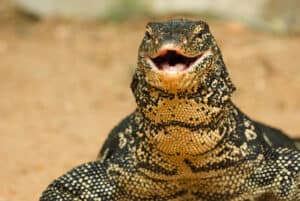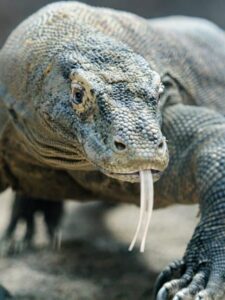Komodo dragons are among the most mesmerizing members of the large monitor lizard family. Unsurprisingly sizable, nocturnal, and solitary, these vulnerable creatures are only found at zoos and in several Indonesian islands, including Komodo, Pada, and Flores. As expected, their rarity – combined with their intriguingly prehistoric looks – has piqued the interest of many, including pet lovers yearning to own and care for them in their homes.
But can you keep a Komodo dragon as a pet? Well, here’s a real bummer — no! Possessing these animals is illegal because they’re endangered species in dire need of special handling and protection. Be that as it may, some people wonder if they’d make safe companions at home.
This article weighs in on the safety of keeping the Komodo dragon as a pet and offers more critical information about the lizard. If you’re still hunting for a pal that is just as interesting, we’ll also put you on the right track.
Is It Safe to Keep Komodo Dragons as Pets?
While the Komodo dragon isn’t typically aggressive, it’s dangerous to humans and animals, making it unsafe to keep the lizard as a pet. Its tooth serrations harbor up to 50 bacterial strains, some of which are septic and found in its saliva. The creature’s bite is highly venomous as it deters blood from clotting; this, therefore, causes its prey or victims to bleed profusely and go into shock.
But safety is only one of the concerns of keeping the Komodo dragon as a pet. Here are more reasons it wouldn’t make a good companion:
It’s Difficult to Control
Any experienced keeper will tell you that a pet is only as good as its capability to submit. Unfortunately, the Komodo dragon isn’t easy to handle because it hates being disturbed and may attack or bite if you persist. Add its large size into the bargain, and you’ll understand why many lizard lovers would rather look for other, more manageable pets.
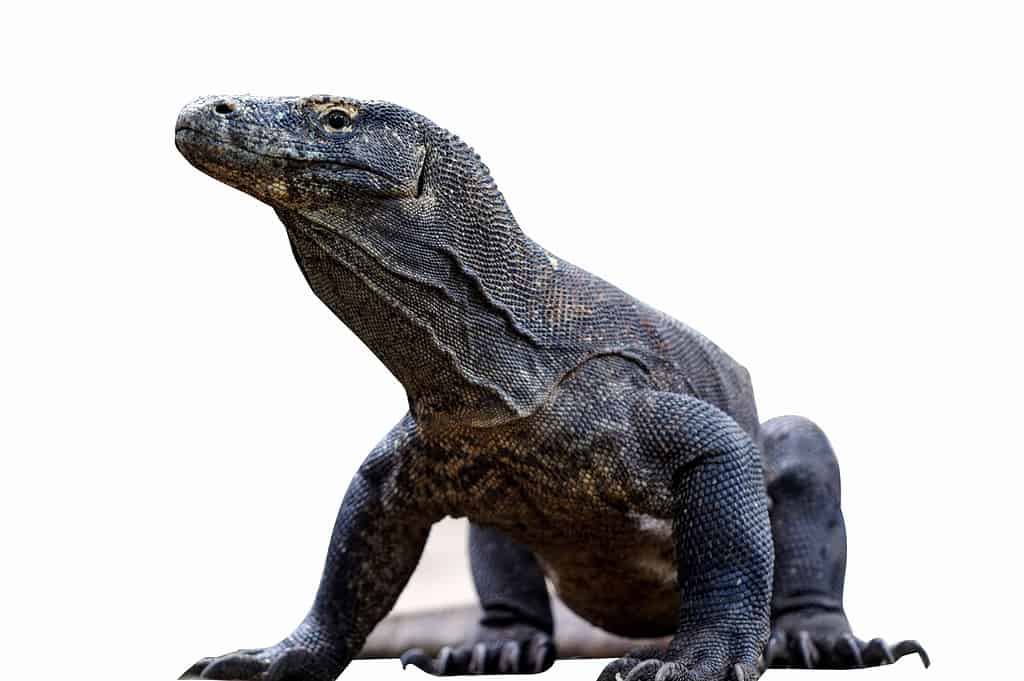
Komodo dragons are notoriously hard to tame. These lizards are highly unpredictable and can be quite dangerous – best admire from afar.
©iStock.com/MikeLane45
It Eats a Lot
Another valid reason the Komodo dragon wouldn’t be an ideal pet is its high appetite. That, combined with its stomach expansion, allows it to eat up to 80% of its body weight in one meal. Although you can feed them only 12 times annually, that would still cost you a large sum considering most adults weigh around 150 pounds.
It Takes Up a Lot of Space
Again, Komodo dragons would burden most at-home caretakers because they require large enclosures (up to 250 square feet) thanks to their large sizes. That’s not all. In addition to providing such a vast indoor space, they also need an outdoor area where they can roam and sunbathe to facilitate food digestion.
Furthermore, Komodo dragons’ enclosures must have an ideal temperature of 95 degrees Fahrenheit. If you live in cold areas, you’d have to provide artificial heat, prompting you to spend more money. Ultimately, keeping these lizards would require building a ‘mini-zoo,’ which most pet lovers aren’t ready for.
You Can’t Tame It
Some argue that if you keep a Komodo dragon long enough, you can successfully tame it. But the truth is, reptiles like these lizards aren’t like dogs or cats. Because they’re not wired to bond with their caregivers, even trying to domesticate them at a young age would still not make them safe-enough pets.
Top 10 Amazing Alternatives to Komodo Dragons
Homing a Komodo dragon is one of those dreams you’ll never see come to fruition. But cheer up! These ten reptile species make wonderful alternatives worth your time and resources:
1. Crested Geckos
The crested gecko, or the eyelash gecko, is a large lizard species that has found favor with both beginner and experienced keepers. This adorable creature’s main selling point is its docile nature; it is super friendly and rarely bites, meaning your little ones will be safe around it.
Additionally, crested geckos have the looks, coming in color variations like cream, orange, red, brown, pink, olive, and tan. You’ll see hair-like projections above their eyes and dark stripes running from their backs down their bodies’ sides.
With proper care, these geckos can live up to 15-20 years, so they fit the bill if you want a long-term commitment.

Crested geckos make great pets due to their docile nature, ease of care, and captivating coloration.
©iStock.com/simmo0498
2. Bearded Dragons
The bearded dragon is another reptile you can get instead of a Komodo dragon. Thanks to its exotic dragon-like appearance, it’s equally attractive. But it brings a lot more to the table because it’s easy-going and friendly, making it an excellent pet for adults and children.
Since bearded dragons boast a lifespan of 15 or more years, they’ll make the perfect long-term companion. You can hang out with them anytime; their size allows you to comfortably place them on your shoulders or in your hand.
Fortunately, they don’t require much attention — just set up their enclosure and provide a balanced diet with fruits, vegetables, and insects. You should feed them daily, but they won’t die or fall ill if you miss a day.
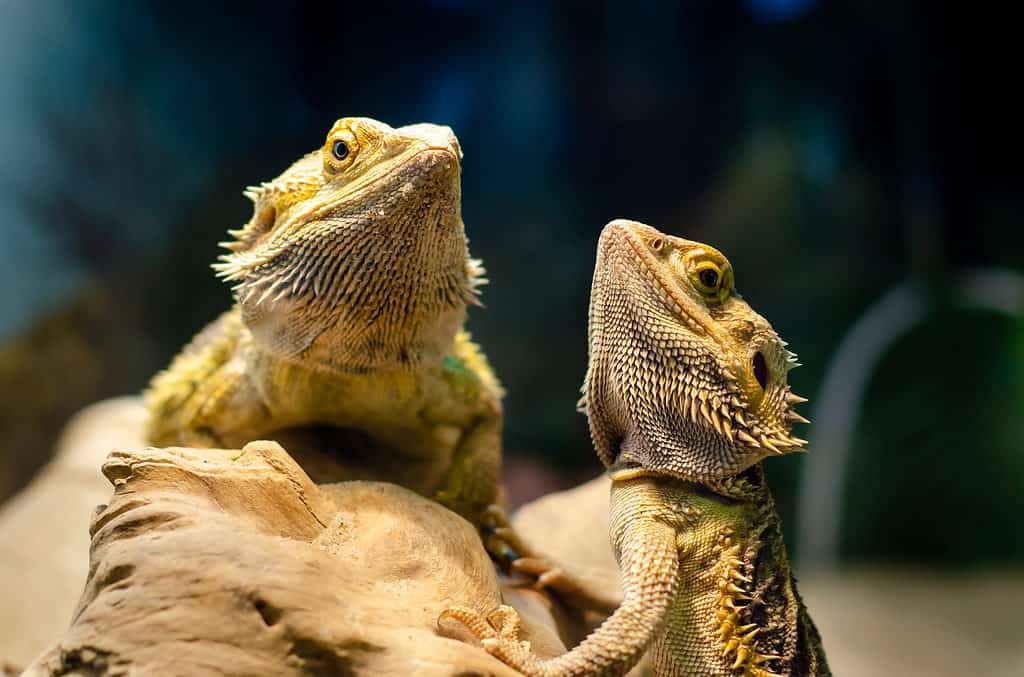
Thanks to their friendly demeanor and small size, bearded dragons make an excellent pet that’s far less intimidating than a Komodo dragon.
©Lutsenko_Oleksandr/Shutterstock.com
3. Blue-Tongued Skink
Approachable, submissive, and incredibly intelligent, the blue-tongued skink is popular among passionate keepers. Additionally, this diurnal lizard is easy to care for, so both amateurs and experienced owners can easily home it as long as they meet its housing needs. Ideally, it requires a large enclosure with a tight lid, such as a 55-gallon tank.
These species are ground dwellers, so there’s no need to provide branches for climbing. Still, you should put a large but shallow water dish in their enclosures because they fancy bathing frequently. The only downside is they also defecate there, prompting you to clean their housing regularly.
Moreover, provide your blue-tongued skink with plenty of hiding spots because the lizards enjoy burrowing and hiding. Sunlight is essential for bone health and metabolism, so we recommend full-spectrum UVA/UVB light for up to 12 hours daily.
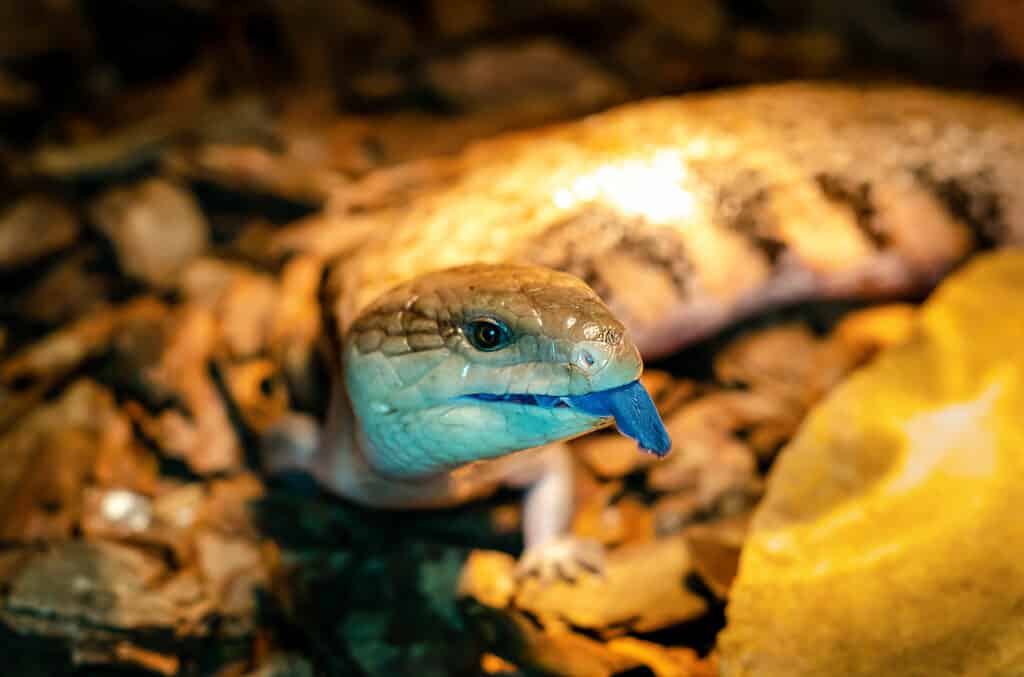
Unlike Komodo dragons, blue-tongued skinks are not dangerous and won’t grow to huge sizes. Plus, they come in a variety of bright colors and patterns.
©Lutsenko_Oleksandr/Shutterstock.com
4. Chinese Water Dragon
If you’re an intermediate keeper, a Chinese water dragon could prove a great addition to your pet family. These members of the family Agamidae are even more cordial than the iguanas! Most people are also drawn to their unique exotic looks — their upper bodies boast light and dark green coloring, and their long tails have a dark brown or sometimes dark green band.
In contrast, their bellies are usually more delicate, with a pale green, white, or yellow shade.
Most male Chinese water dragons grow up to 3 feet long, but the females are smaller, often reaching heights of only 2 feet. Still, both genders’ lifespan is about 15 years, though some live up to 20 years with excellent care.
Keep in mind that housing a Chinese water dragon requires a considerable level of commitment. Regularly monitor the animal, and see to it that it eats a balanced diet. Interestingly, despite being an omnivore, it prefers meat to vegetables and fruits. The lizard also boasts an insatiable appetite, so you might have to create a feeding schedule to ensure it gets diverse meals daily.
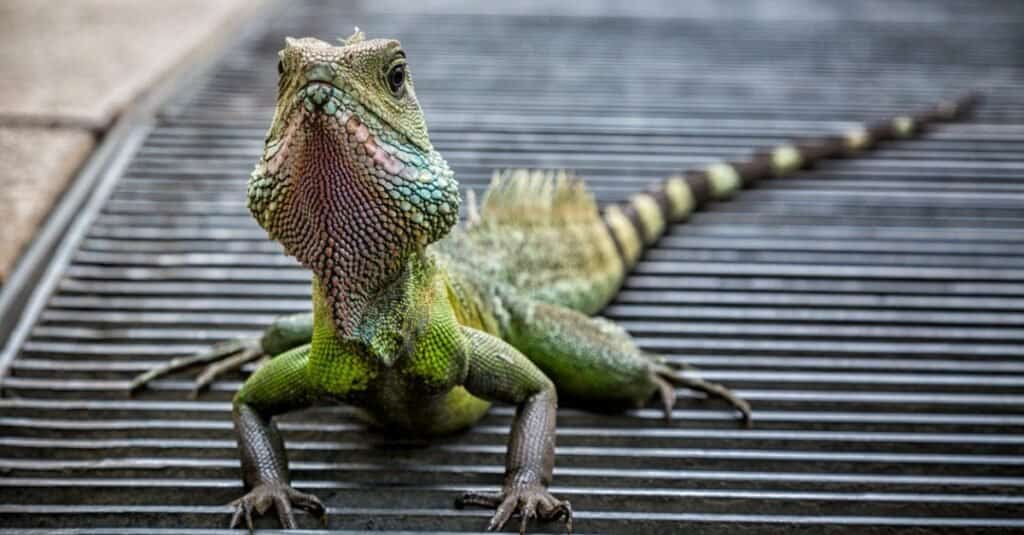
With their soft yet vibrant color palette and playful demeanor, Chinese water dragons are a great alternative to Komodo dragons for those looking for an exotic pet.
©iStock.com/Nigel Jarvis
5. Spiny-Tailed Monitor
You don’t need a permit to buy and keep the spiny-tailed monitor. Most of these lizards live up to three decades, meaning you should only get them if you’re ready for a serious commitment. Also, they’re suitable for intermediate or advanced keepers; most beginners have confessed to finding caring for them highly demanding.
Like most lizards, the spiny-tailed monitor enjoys variety in its diet. They’re carnivores that like insects and spiders. You can also feed them turkey, bird eggs, and smaller lizards several times weekly.
One of the challenges you might face when keeping a spiny-tailed lizard is its reclusive nature. More often than not, it’ll try to stow away whenever you try to hold it. Even worse, it may become defensive and bite you if improperly handled.
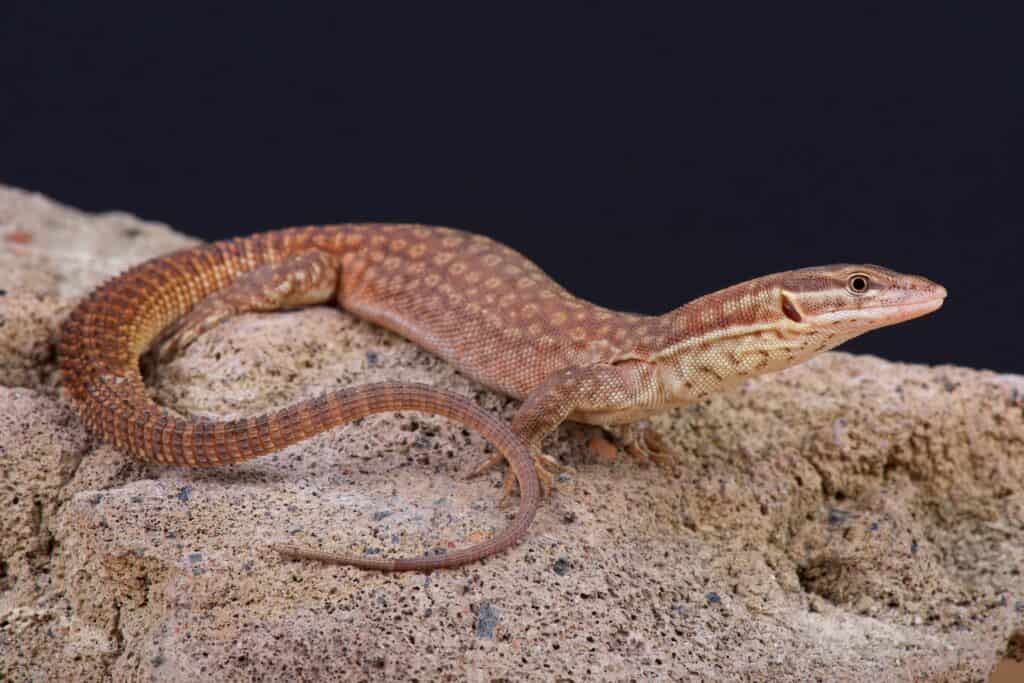
Those looking for an interesting reptilian pet should consider the spiny-tailed
monitor lizard
. Unlike Komodo dragons, these lizards have a milder temperament and are less prone to aggression.
©reptiles4all/Shutterstock.com
6. Frilled Dragon
You can’t go wrong with the frilled dragon if you want a unique but captivating alternative to the Komodo dragon. This species is scarce and can only be bought from breeders or as an imported animal. But thankfully, it’s legal to own it in most parts of the world, save for a few. These include Tasmania and Western Australia, where keepers require a license to home the lizard.
Frilled lizards are mainly solitary, shy, and docile. But sometimes, they don’t like daily handling and may try to flee when you try to hold them. Also, they’re native to southern New Guinea and Australia, which are typically warmer. Therefore, we recommend keeping them in a wooden vivarium to match their preferred environment and enhance their comfort.
Opt for a blend of potting soil, play sand, and coconut fibers for substrates. However, it can be hard to clean, making spotting scats difficult and paving the way for bacterial growth.

These reptiles are low maintenance, require minimal food and heating requirements, and can live for years. Plus, their bright colors make them a great addition to any home.
©Susan Schmitz/Shutterstock.com
7. Rankin’s Dragon
The charming, good-looking Rankin’s dragon is a favorite for many keepers who fancy reptile species. It’s native to Queensland, Australia, which declared the exportation of the animal illegal. Therefore, you’ll only find it in some parts of the globe. But if you’re in the state, you can easily acquire it from local pet stores or private breeders.
Some people confuse the Rankin’s dragon with the bearded dragons, but they’re smaller. However, these reptiles boast the same lifespans since they can live for between 10 and 15 years or more if healthy.
Feeding Rankin’s Dragons
The Rankin’s dragon is a fantastic pet because it’s low-maintenance. We recommend a high-quality protein-rich diet for the younger ones, including live cockroaches, silkworms, crickets, and locusts. As it ages, you can throw in vegetation like dandelion, arugula, and collard greens.
Rankin’s dragons often stay hydrated by leveraging the air’s humidity or lapping water droplets in their enclosures. Still, you should put a dish of clean water in the latter. Even if they don’t drink it, they’ll enjoy soaking in it often.
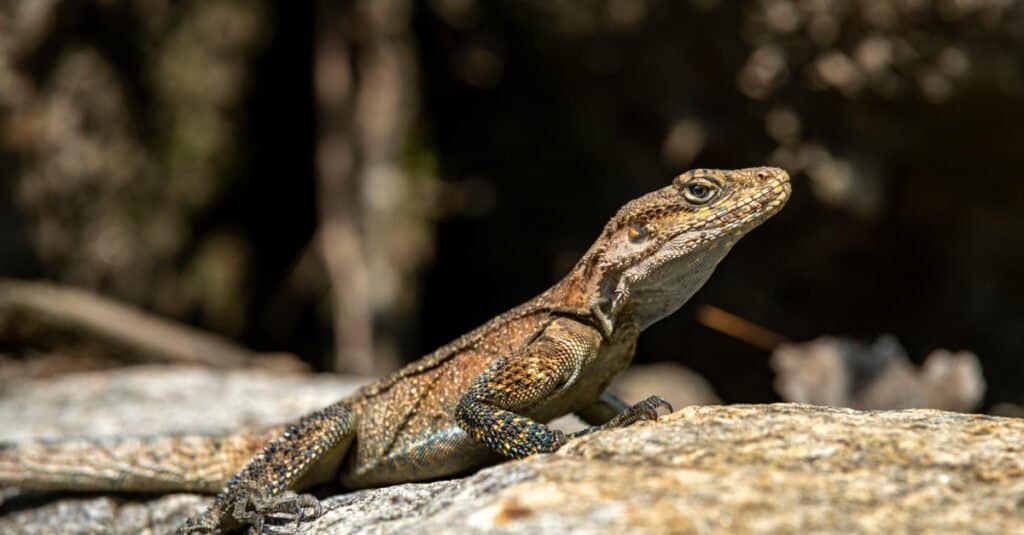
Rankin’s dragon is a great alternative to the Komodo dragon, with similar features but on a smaller scale.
©thsulemani/Shutterstock.com
8. Green Basilisk
Otherwise known as plumed lizards, the Green Basilisks are another popular species in the reptile scene; They’re famous for their gorgeous, electric green bodies boasting gray, light blue, or white patches. Their bodies are usually light green, and the males have an exalted dorsal chest, which makes them easier to identify.
Most plumed lizards roam this earth for about ten years. But of course, you must play your part to help them brighten your life for such a long time. Ensure their diet contains healthy options like:
- Insects
- Small rodents
- Crickets
- Worms
- Carrots
- Sweet potatoes
Adult plumed lizards live for fruits like mangos and blueberries. But these are not suitable for babies because they cause diarrhea.

Green basilisk lizards make great pets – they are much smaller and less dangerous than Komodo dragons, but still have the same exotic look.
©fivespots/Shutterstock.com
9. Mexican Alligator Lizard
Although the Mexican alligator lizard is endangered like the Komodo dragon, keeping it as a pet is lawful. The species has bright green skin, visibly defined scales, and a unique texture that sets them apart from other lizards. To add to their charm, they have a white ring around their eyes; it makes them look like they’re staring at you.
With excellent farming and the right environment, the Mexican alligator lizard can be your partner for up to 20 years. These reptiles are often docile but tend to bite when provoked. Fortunately, unlike the infamous Komodo dragon, its saliva is not venomous, so you don’t have to worry about adverse effects.
Keeping Mexican Alligator Lizards as Pets
The Mexican alligator lizard is best suited for intermediate or advanced keepers because of its demanding nature. We recommend a vivarium for its housing because it’s easy to clean and makes caring for the reptile a piece of cake. Then, when choosing your substrate, consider peat moss, newspaper, paper towels, or sphagnum moss, and ensure the layer is several inches long. Doing so will help retain moisture and provide the ideal humidity level of 80% for these reptiles.
Like most lizards, Mexican alligator lizards don’t drink water. But they depend on the moisture around their enclosures, so we recommend misting them regularly. However, as you do so, confirm the water is free from chemicals like chlorine for your scaly buddy’s well-being.
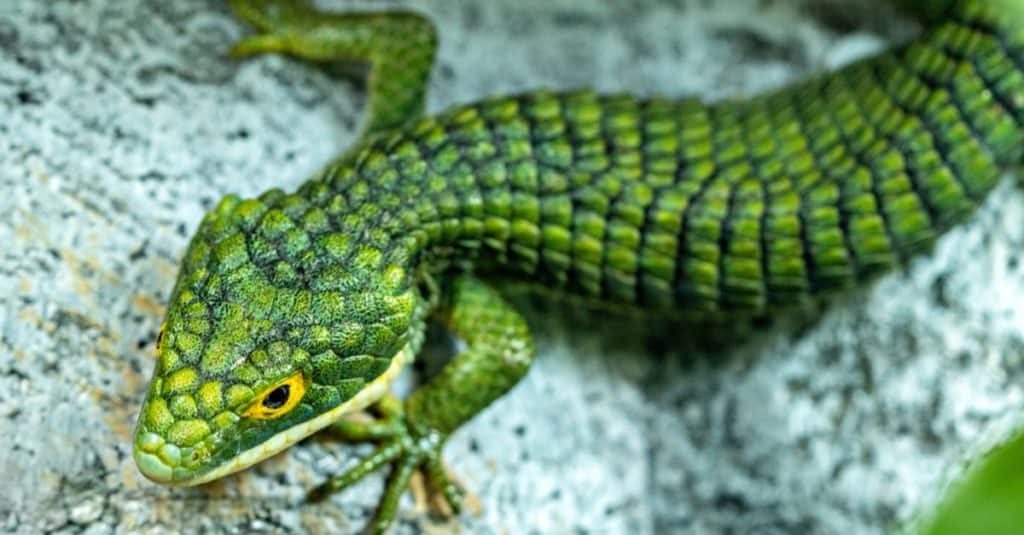
The Mexican alligator lizard is significantly smaller than their Indonesian counterparts, so they make great companions in smaller homes.
©Wesley Aston/Shutterstock.com
10. Armadillo Lizard
The Armadillo lizard is last on our list of the top 10 best Komodo dragon alternatives. It resembles a tiny dragon with a pair of wings and a flame thrower; this species can easily fit into HBO’s hit series Game of Thrones! But the reptile’s looks are just one of the many reasons people adore it.
Ideally, Armadillo dragons require minimal care. So, you can spend the next twenty years together without devoting your entire life to caring for it. Moreover, many live specimens are online and offline, making securing yours a breeze.
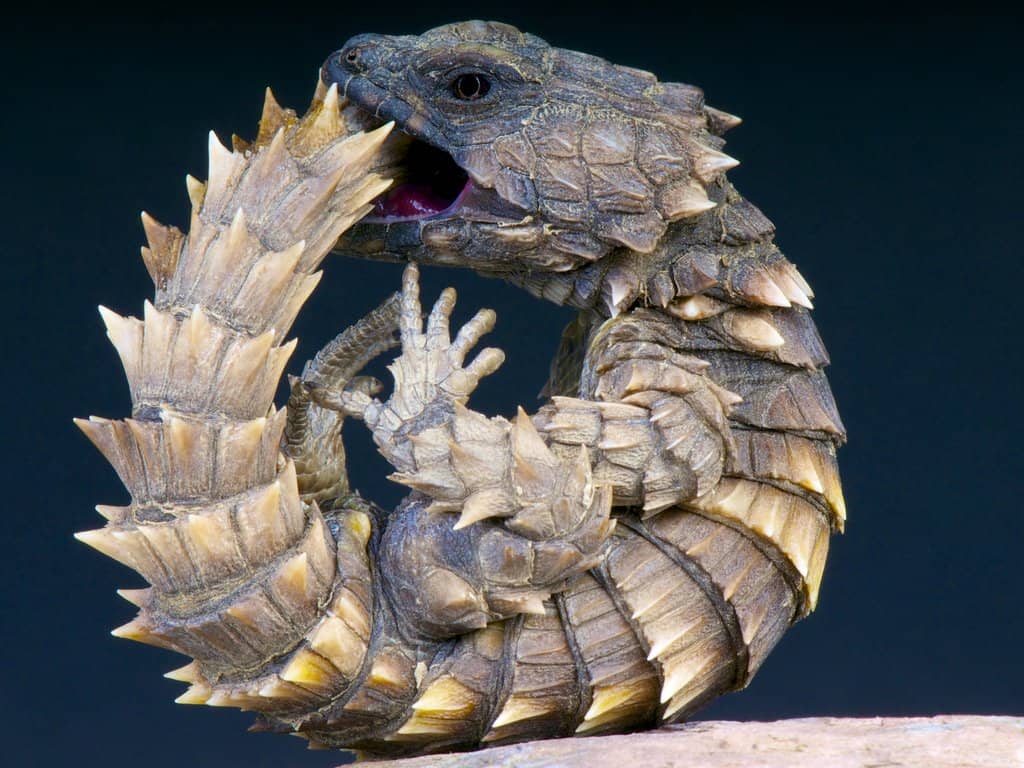
The armadillo lizard is a great alternative to the Komodo dragon. It’s smaller in size and has fewer health concerns due to its omnivorous diet.
©reptiles4all/Shutterstock.com
Keeping Komodo Dragons as Pets
As we’ve seen above, you can’t house the Komodo dragon as it’s on the International Union for Conservation of Nature’s list of endangered animals. But even if the organization declared it invulnerable, we’d still not endorse it as a companion because – despite its beautiful nature – it’s aggressive and venomous. Having it in your home could endanger your children, friends, and pets, which is the last thing you want.
But if you still want a pet in the reptile family, consider the lovable options we’ve discussed above. Some boast fewer care requirements than traditional picks like cats and dogs and are ideal for beginners. But others need advanced handling and are best for experienced keepers. Nevertheless, they’re all unique and could provide the companionship you yearn for.
The photo featured at the top of this post is © iStock.com/desertsolitaire
Thank you for reading! Have some feedback for us? Contact the AZ Animals editorial team.



